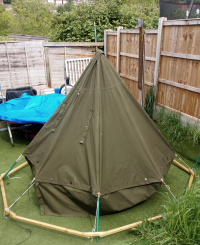Any lean to shelter protects you against the wind and creates a heated space if used with a fire in front of it.
Don't imagine a pretty heavy wind on a beach. If camping the main problem usually is just a light cold wind. If you cut it off you immediately become comfortable.
I don't know if it's physically correct but you can imagine that the lean to shelter reflects the heat of the fire to your back. Perhaps it's just the heated room, but it doesn't really matter why exactly it gets comfortable.
Because I don't own such a polish army tent I don't know if just half a tent can be protective enough against rain but just looking at it I think so. Surely not in the open field but well protected against wind in the woods it surely works fine, depending on the tent size and body size of course.
Historic photos usually show standard constructions because such a tent works always and everywhere and modern soldiers usually don't sleep by the fire. It's better for them to count in the body heat of the second man in the tent.
Since WW1 a soldier has to count in a sudden air plane attack. One doesn't ignite several fires to show the enemy where he should throw the bomb or shoot in with the machine gun. The Stuka was for sure not the nicest German idea and surely never will get forgotten in polish military circles. They already did hit the target in the beginning of WW2. In the cold war aera the weapons became even far more precise.
The best civil use of military surplus equipment often is different to the way that was intended by the military.
The usual NATO tent halves for example we usually used seperated with a fire in between, forming a triangle or a U shape.
It's constructed like this but rarely used like this in armies.
A soldier in the field usually doesn't sit comfortably around the fires. His boss (if not the enemy) already made him tired enough that he sleeps as soon as possible.
Don't imagine a pretty heavy wind on a beach. If camping the main problem usually is just a light cold wind. If you cut it off you immediately become comfortable.
I don't know if it's physically correct but you can imagine that the lean to shelter reflects the heat of the fire to your back. Perhaps it's just the heated room, but it doesn't really matter why exactly it gets comfortable.
Because I don't own such a polish army tent I don't know if just half a tent can be protective enough against rain but just looking at it I think so. Surely not in the open field but well protected against wind in the woods it surely works fine, depending on the tent size and body size of course.
Historic photos usually show standard constructions because such a tent works always and everywhere and modern soldiers usually don't sleep by the fire. It's better for them to count in the body heat of the second man in the tent.
Since WW1 a soldier has to count in a sudden air plane attack. One doesn't ignite several fires to show the enemy where he should throw the bomb or shoot in with the machine gun. The Stuka was for sure not the nicest German idea and surely never will get forgotten in polish military circles. They already did hit the target in the beginning of WW2. In the cold war aera the weapons became even far more precise.
The best civil use of military surplus equipment often is different to the way that was intended by the military.
The usual NATO tent halves for example we usually used seperated with a fire in between, forming a triangle or a U shape.
It's constructed like this but rarely used like this in armies.
A soldier in the field usually doesn't sit comfortably around the fires. His boss (if not the enemy) already made him tired enough that he sleeps as soon as possible.

